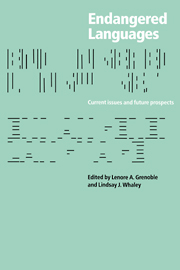Book contents
- Frontmatter
- Contents
- Preface
- List of abbreviations and symbols
- Part I General issues
- Part II Language-community responses
- Part III What is lost: language diversity
- Part IV Mechanisms of language loss
- 11 Impact of language variation and accommodation theory on language maintenance: an analysis of Shaba Swahili
- 12 A way to dusty death: the Matrix Language turnover hypothesis
- 13 Copper Island Aleut: a case of language “resurrection”
- Appendix
- References
- Index of languages
- Index of names
- General index
13 - Copper Island Aleut: a case of language “resurrection”
Published online by Cambridge University Press: 05 June 2012
- Frontmatter
- Contents
- Preface
- List of abbreviations and symbols
- Part I General issues
- Part II Language-community responses
- Part III What is lost: language diversity
- Part IV Mechanisms of language loss
- 11 Impact of language variation and accommodation theory on language maintenance: an analysis of Shaba Swahili
- 12 A way to dusty death: the Matrix Language turnover hypothesis
- 13 Copper Island Aleut: a case of language “resurrection”
- Appendix
- References
- Index of languages
- Index of names
- General index
Summary
Introduction: language “life” versus “death”
When “endangered languages” are mentioned, normally people have in mind the danger of language death, the danger of a language disappearing from the linguistic map of the world. However, in my opinion the situation here is more complicated than one of just “the language is alive versus the language is dead.” Language is a highly viable and an extremely flexible system; it is often not at all easy to eradicate a language.
I would like to present here an example of the outstanding viability of a native language. This particular case exemplifies a Russian–Native contact of extreme intensity and duration (of over 150 years). Current linguistic research in language endangerment suggests that the native language in question should have become extinct long ago, but in reality the situation is very different. This does not mean I am overly optimistic about the fate of endangered native languages; I simply wish to stress that there are other possibilities besides linguistic “life” and “death,” especially at times of sharp turns of history, such as the one Russia is living through now. To an external observer, a caterpillar in a cocoon does not show any sign of life. It looks dead, but it is not dead: it has ceased to be a caterpillar, but in due time it will become a butterfly, and the life of the organism will continue, though the form of life will become different.
- Type
- Chapter
- Information
- Endangered LanguagesLanguage Loss and Community Response, pp. 317 - 327Publisher: Cambridge University PressPrint publication year: 1998
- 7
- Cited by



